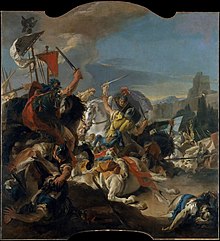User:Latium/Sandbox6: Difference between revisions
Jump to navigation
Jump to search
No edit summary |
No edit summary |
||
| (75 intermediate revisions by 2 users not shown) | |||
| Line 1: | Line 1: | ||
{{Region_icon_Ajax}} | {{Region_icon_Ajax}} | ||
{{Infobox royalty | |||
{{Infobox | | name = Constantine | ||
| | | title = [[Prince of Youth]]<br>[[Monarchy of Latium#Heir apparent|Imperator Destinatus]] | ||
| image = Tiepolo Vercellae.jpg | |||
| image_size = 220px | |||
| caption = Constantine's death at the Battle of Telesia, c. 18th century | |||
| succession = | |||
| moretext = | |||
| reign = | |||
| coronation = | |||
| cor-type = | |||
| predecessor = | |||
| | | successor = | ||
| | | regent = | ||
| reg-type = | |||
| | | spouses = {{marriage|[[Maria Tarpeia (11th century)|Maria Tarpeia]]|1039}} | ||
| issue = {{ubl | |||
| | | [[Ascanius III Claudius]] | ||
| | |||
| | |||
| | |||
| | |||
| | |||
| | |||
| | |||
| | |||
| | |||
| | |||
}} | }} | ||
| | | issue-link = | ||
| | | issue-pipe = | ||
| | | full name = Gaius Claudius Sabinus Constantinus Marius Ascanius | ||
| | | dynasty = [[Claudian dynasty|Claudian]] | ||
| father = [[Ascanius II Claudius]] | |||
| | | mother = [[Maria I Claudia]] | ||
| birth_date = 1017 | |||
| birth_place = [[Palatium Supranio]], [[Adrianople]], [[Latium]] | |||
| death_date = {{Death date and age|1045|11|19|1017|1|1|df=y}} | |||
| death_place = near [[Telesia]], [[Latium]] | |||
| place of burial = | |||
| signature = | |||
| religion = [[Imperial Latin Church|Imperial Church]] ([[Fabrian Catholic Church|Catholicism]]) | |||
|}} | |||
| | '''Constantine, Prince of Youth''' was a [[Latium|Latin]] a Latin prince, and heir apparent to the [[Monarchy of Latium|Latin throne]] as the eldest child and son of [[Maria I Claudia]] and [[Ascanius II Claudius]]. His death is marked by many historians as the end of the [[Latium#Imperial era|classical empire]], and point of no return in downfall of the Claudian dynasty and [[Crisis of the Eleventh Century]] | ||
| | |||
| | |||
| | |||
| | |||
| | |||
| | |||
| | |||
| | |||
}} | |||
= | |||
[[category:Latin's user page and sandboxes]] | [[category:Latin's user page and sandboxes]] | ||
Latest revision as of 00:18, 28 May 2024
| Constantine | |||||
|---|---|---|---|---|---|
| Prince of Youth Imperator Destinatus | |||||
 Constantine's death at the Battle of Telesia, c. 18th century | |||||
| Born | 1017 Palatium Supranio, Adrianople, Latium | ||||
| Died | 19 November 1045 (aged 28) near Telesia, Latium | ||||
| Spouse | Maria Tarpeia (m. 1039) | ||||
| Issue | |||||
| |||||
| Dynasty | Claudian | ||||
| Father | Ascanius II Claudius | ||||
| Mother | Maria I Claudia | ||||
| Religion | Imperial Church (Catholicism) | ||||
Constantine, Prince of Youth was a Latin a Latin prince, and heir apparent to the Latin throne as the eldest child and son of Maria I Claudia and Ascanius II Claudius. His death is marked by many historians as the end of the classical empire, and point of no return in downfall of the Claudian dynasty and Crisis of the Eleventh Century